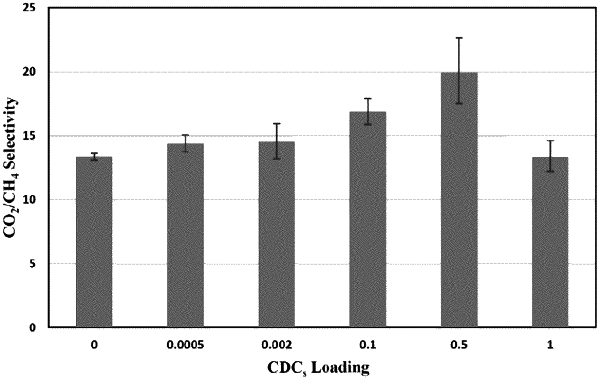| CPC B01D 69/148 (2013.01) [B01D 53/228 (2013.01); B01D 67/00791 (2022.08); B01D 67/00793 (2022.08); B01D 69/12 (2013.01); B01D 69/1251 (2022.08); B01D 71/0211 (2022.08); B01D 71/0212 (2022.08); B01D 71/56 (2013.01)] | 6 Claims |

|
1. A method for making and using a gas separation membrane, comprising:
first, forming a support layer by phase inversion of a solution of polysulfone in an organic solvent to form a porous support, then
forming a polyamide layer on the porous support by interfacial polymerization of a mixture comprising piperazine, isophthaloyl chloride and carbide-derived carbon (CDC) nanoparticles to form a precursor film, then
drying and curing the precursor film to form a multilayered membrane;
passing a gas mixture, comprising CO2 and at least one additional gas, through a gas filter to form a permeate that is enriched in CO2 content and a gaseous composition having a concentration of CO2 that is less than a concentration of CO2 in the gas mixture,
wherein the gas filter comprises:
a plurality of the multilayered membranes fixed inside a cell;
wherein each multilayered membrane of the plurality of multilayered membranes comprises:
the support layer, comprising at least 50 wt. % of the polysulfone;
the polyamide layer, comprising at least 50 wt. % of the piperazine and the isophthaloyl chloride, in condensation polymerized form; and
wherein the CDC nanoparticles are selected from the group consisting of SiC, Fe3C, WC, Ti3SiC2, ZrC, B4C, TaC, Mo2C, and TiC-derived nanoparticles, wherein the CDC nanoparticles are embedded in the second layer in an amount of from 0.005 to 0.5 wt. %, based on a total weight of the second layer,
wherein the first layer directly contacts the second layer.
|